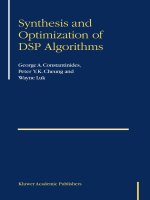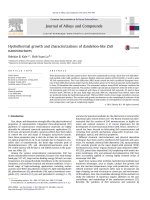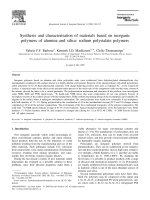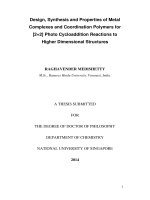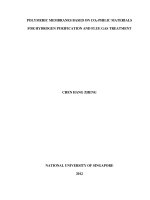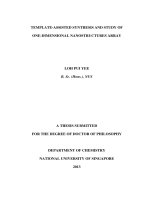Synthesis and characterizations of polymer electrolyte membranes based on aliphatic ionomers
Bạn đang xem bản rút gọn của tài liệu. Xem và tải ngay bản đầy đủ của tài liệu tại đây (2.92 MB, 185 trang )
SYNTHESIS AND CHARACTERIZATIONS OF
POLYMER ELECTROLYTE MEMBRANES BASED ON
ALIPHATIC IONOMERS
DAVID JULIUS
NATIONAL UNIVERSITY OF SINGAPORE
2011
Thesis Spine
SYNTHESIS AND CHARACTERIZATIONS OF POLYMER
ELECTROLYTE MEMBRANES BASED ON ALIPHATIC IONOMERS
DAVID JULIUS
2011
SYNTHESIS AND CHARACTERIZATIONS OF POLYMER
ELECTROLYTE MEMBRANES BASED ON ALIPHATIC
IONOMERS
DAVID JULIUS
(B. Eng., UNPAR; M. Sc., NUS)
A THESIS SUBMITTED
FOR THE DEGREE OF DOCTOR OF PHILOSOPHY
DEPARTMENT OF CHEMICAL AND BIOMOLECULAR ENGINEERING
NATIONAL UNIVERSITY OF SINGAPORE
2011
i
ACKNOWLEDGEMENT
First of all, I would like to express my deepest and greatest gratitude to my main
supervisor, Professor Lee Jim Yang, and my co-supervisor, Associate Professor Hong
Liang, for their guidance, patience, support and advices throughout my entire PhD
study. Prof. Lee has been the maestro conductor in this PhD thesis study. Like a
symphony, he helped me to set the tempo, prepared me for the execution, and listened
and critiqued my performance. He shaped the direction of the research project and the
physical form of the thesis as it is presented today. His inspirational stories and
unconventional ideas have always been a source of motivation. Prof. Hong, on the
other hand, has been my resourceful chef de cuisine, who is in charge of the details of
the scientific investigation. His immense knowledge in polymer chemistry has helped
me overcome many synthesis difficulties and rationalized many of the “perplexing”
observations encountered in this study. I am grateful to National University of
Singapore, in particular the Chemical and Biomolecular Engineering department for
their generous scholarship supports that make this study possible.
I would also like to thank my close friends and colleagues in our research group
with whom I have formed a strong bond: Dr. Nikken Wiradharma, Dr. Deny Hartono,
Mr. Usman Oemar, Dr. Natalia Widjojo, Ms. Fang Chunliu, Dr. Fu Rongqiang, Dr.
Tay Siok Wei, Dr. Zhang Xinhui, Dr. Pei Haiqing, Dr. Zhou Weijiang, Dr. Zhang
Qingbo, Mr. Cheng Chin Hsien, Dr. Deng Da, Dr. Yang Jinhua, Ms. Yu Yue, Ms. Lu
Meihua, Ms. Ji Ge, Mr. Ma Yue, Mr. Bao Ji, Mr. Chia Zhi Wen, Mr. Yao Qiaofeng,
Mr. Chen Dongyun, Dr. Liu Bo, Dr. Zhang Cao. My indebtedness also goes to all
friends that had supported me in many ways during my PhD studies. I also want to
ii
express my gratitude to Mr. Boey Kok Hong, Ms. Lee Cai Keng, Mr. Chia Pai An,
Mr. Mogan, Ms. Samantha Fam, Dr. Yuan Ze Liang, and to all laboratory and
professional staffs in Chemical and Biomolecular Engineering department for their
technical assistance. The support, friendship, and encouragement of these people have
helped to make this PhD study a journey of happiness.
Thanks are also extended to my PhD examination panel, A/Prof. Loh Kai Chee,
A/Prof. Chen Shing Bor, and Asst/Prof. Karl Erik Birgersson, for their valuable
assessment and suggestion on this thesis and my future career. I would to express my
sincere thank to Professor Peter N. Pintauro, who has been my inspiring teacher in
this research study. Last but not least, I would like to thank my family members: my
parents, my brothers, and also to my fiancée. Without their support and
encouragement, I may not finish writing up this piece of work.
iii
TABLE OF CONTENTS
ACKNOWLEDGEMENT i
SUMMARY vii
NOMENCLATURES x
LIST OF FIGURES xiii
LIST OF TABLES xix
INTRODUCTION 1
1.1 Problem Statement 1
1.2 Objective and Scope of Thesis 4
(a) Design and Synthesis of New Alcohol-Resistant Alternative PEMs based
on Aliphatic Random Ionomers 5
(b) Structural Characterizations of Random Aliphatic Ionomers and
Investigations of the Effects of Hydrophobic Functional Groups on
Phase Separation in Solution 5
(c) Development of New PEMs based on Aliphatic Block Ionomers and
Hydrophilic Covalent Cross-links 6
(d) Investigations of a One-pot ATRP Method and the Phase Separation of
Aliphatic Block Ionomers in Solution 7
1.3 Organization of Thesis 7
LITERATURE REVIEW 8
2.1 Scope of the Review 8
2.2 Ionomers for DAFC Applications 8
2.2.1 DAFCs 8
2.2.2 Membrane Electrode Assembly (MEA) 10
2.2.3 Ionomers for Polymer Electrolyte Membranes (PEMs) 12
2.2.3.1 Modified Nafion
®
Membranes 13
2.2.3.2 Hydrocarbon Membranes 18
2.3 Ionomers: Synthesis, Structure, and Properties 24
2.3.1 Synthesis of Ionomers: Radical Polymerization 25
2.3.1.1 Synthesis of Random and Block Ionomers 25
2.3.1.2 Atom Transfer Radical Polymerization (ATRP) 29
2.3.2 Phase Separation of Ionomers in Solution and in the Solid State 32
iv
2.3.2.1 Phase Separation of Random and Block Ionomers in Solution 33
2.3.2.2 Phase Separation of Random and Block Ionomers in the Solid
State 36
SYNTHESIS AND CHARACTERIZATION OF ACRYLIC RANDOM-
IONOMER MEMBRANES FOR ROOM TEMPERATURE DIRECT
ETHANOL FUEL CELLS 41
3.1 Introduction 41
3.2 Experimental Method 43
3.2.1 Materials 43
3.2.2 Synthesis of Random Ionomers 44
3.2.3 Fabrication of Random-Ionomer Membranes 45
3.2.4 Characterization Methods 46
3.2.4.1 Proton Conductivity 46
3.2.4.2 Alcohol Permeability 47
3.2.4.3 Ion-Exchange Capacity (IEC) and Water Uptake 48
3.2.4.4 Mechanical Properties 48
3.3 Results and Discussion 49
3.3.1 Ternary Random-Ionomer Membranes for DEFCs 49
3.3.1.1 Rational Design and Synthesis of Ethanol-Resistant Random-
Ionomer Membranes 49
3.3.1.2 PEM Properties of the Ternary Random-Ionomer Membranes 53
3.3.2 The Benevolent Effects of the Addition of Strongly Hydrophobic TFPM
to Form Quaternary Random-Ionomer Membranes 54
3.3.2.1 Proton Conductivity 55
3.3.2.2 Ethanol Permeability 58
3.3.2.3 Mechanical Properties 61
3.3.3 Reflection on the Design Strategy for Aliphatic Ionomer Membranes 64
3.4 Conclusion 65
MITIGATING EARLY PHASE SEPARATION DURING SOLUTION
POLYMERIZATION OF ALIPHATIC RANDOM IONOMERS BY
HYDROPHOBIC MODIFIER ADDITION 66
4.1 Introduction 66
4.2 Experimental Method 69
4.2.1 Synthesis of Random Ionomers and Membrane Fabrications 69
v
4.2.2 Additional Characterization Methods 69
4.2.2.1 Viscosity 69
4.2.2.2 Zeta Potential 70
4.2.2.3 Laser Light Scattering (LLS) 70
4.2.2.4 Transmission Electron Microscopy (TEM) 71
4.2.2.5 Spectroscopic Analyses 71
4.3 Results and Discussions 71
4.3.1 Effects of Hydrophobic Modifier Addition on Phase Separation during
Copolymerization 71
4.3.2 Influence of Co-monomer Distribution on Solution Behavior 74
4.3.3 Structures of Ternary and Quaternary Random Ionomers 79
4.4 Conclusion 85
DEVELOPMENT OF POLYMER ELECTROLYTE MEMBRANES BASED
ON HYDROPHILIC COVALENTLY CROSS-LINKED ALIPHATIC
DIBLOCK IONOMERS 86
5.1 Introduction 86
5.2 Experimental 90
5.2.1 Materials 90
5.2.2 Synthesis of Aliphatic Diblock Ionomers by a One-pot Atom Transfer
Radical Polymerization (ATRP) Technique 90
5.2.3 Membrane Formation and Pre-treatment 92
5.2.4 Characterization Methods 93
5.2.4.1 Electrochemical Analysis 93
5.2.4.2 Alcohol Permeability 93
5.2.4.3 Ion-Exchange Capacity (IEC), Alcohol and Water Uptake, and
Dimensional Stability 93
5.2.4.4 Examination of Membrane Morphology 94
5.2.4.5 MEA Preparation and DMFC Tests 94
5.3 Results and Discussion 95
5.3.1 Design and Synthesis of Diblock Ionomer Membranes with Hydrophilic
Covalent Cross-links 95
5.3.2 Proton Conductivity 100
5.3.3 Liquid Uptake and Dimensional Stability 103
5.3.4 Alcohol Permeability 107
vi
5.3.5 Membrane Morphologies 111
5.3.6 MEA Fabrication and DMFC Performance 115
5.4 Conclusion 118
ONE-POT SYNTHESIS OF 3-SULFOPROPYL METHACRYLATE-BASED
DIBLOCK IONOMERS AND THEIR PHASE SEPARATION BEHAVIOR IN
SOLUTION 119
6.1 Introduction 119
6.2 Experimental Section 121
6.2.1 Materials and Synthesis of Block Ionomers 121
6.2.2 Additional Characterization Methods 121
6.2.2.1 Chromatographic Analysis 121
6.2.2.2 Spectroscopic Analysis 122
6.2.2.3 Zeta Potential Measurements 123
6.2.2.4 Laser Light Scattering (LLS) Measurements 123
6.2.2.5 Transmission Electron Microscopy (TEM) 124
6.3 Results and Discussion 124
6.3.1 Synthesis and Structure of P(AN-co-GMA)-b-SPM Diblock Ionomers 124
6.3.1.1 Feed Composition 126
6.3.1.2 Processing Conditions 126
6.3.2 Phase Separation Behavior of P(AN-co-GMA)-b-SPM Diblock Ionomers
in DMSO/Water Mixtures 132
6.4 Conclusion 141
CONCLUSIONS AND RECOMMENDATIONS FOR FUTURE WORK 142
7.1 Conclusions 142
7.2 Recommendations for Future Work 145
7.2.1 Other Applications of Hydrophilic Covalently Cross-linked Diblock
Ionomer Membranes 145
7.2.2 Development of Hydrophilic Covalently Cross-linked Diblock Ionomer
Membranes for Medium-Temperature DAFCs 146
PUBLICATIONS AND CONFERENCES 148
Patents 148
Publications 148
Conferences 148
REFERENCES 150
vii
SUMMARY
Ionomers, one of the many important classes of functional polymers, are able to
undergo phase separation either in solution or in the solid state. This unique property
facilitates the formation of a continuous hydrophilic network for ionic transport in
ionomer membranes and is the basis for the design of polymer electrolyte membranes
(PEMs). Many of the PEMs in use today for fuel cells are based on the
perfluorosulfonate polymers, as exemplified by the highly successful commercial
ionomer Nafion
®
. Despite their popularity in hydrogen fuel cells, Nafion
®
membranes
are expensive and weak against alcohol permeation, rendering them less suitable for
the direct alcohol fuel cells (DAFCs). Such material issues prompted the development
of lower cost alcohol resistant alternative ionomers with the desired properties for
DAFC applications (high proton conductivity, low alcohol crossover, and good
mechanical properties). Among them the aliphatic ionomers are low cost and can be
designed to bear organic functional groups that are not solvated by alcohol molecules
and hence contribute to alcohol-blocking properties. This is also the approach taken
by this PhD thesis study which focused on the design and synthesis of two forms of
aliphatic ionomers and investigated the properties of the membranes fabricated from
them. Two different ionomer structures, namely random and block ionomers
consisting of hydrophobic acrylic; and hydrophobic and hydrophilic acrylate
repeating units, were synthesized by free radical polymerization (FRP) and atom
transfer radical polymerization (ATRP) respectively. In-situ cross-linking was also
used to inhibit alcohol permeation and to strengthen the membrane structure.
viii
The first half of this PhD thesis (Chapters 3 and 4) concerned the development
of alcohol-tolerant PEMs for room-temperature DAFCs (especially the direct ethanol
fuel cells, or DEFCs) based on aliphatic random ionomers synthesized by simple and
scalable methodologies. Chapter 3 introduces the design for two such PEMs: (1)
ternary poly(acrylonitrile-co-glycidyl methacrylate-co-sulfopropyl methacrylate)
P(AN-co-GMA-co-SPM) random ionomers and (2) quaternary poly(acrylonitrile-co-
glycidyl methacrylate-co-sulfopropyl methacrylate-co-tetrafluoro propyl
methacrylate) P(AN-co-GMA-co-SPM-co-TFPM) random ionomers; and a fairly
comprehensive characterization of their PEM properties. It was found empirically that
the incorporation of a strongly hydrophobic 2,2,3,3-tetrafluoropropyl methacrylate
(TFPM) component in the ionomer design could suppress early phase separation in
the solution polymerization. The resulting quaternary ionomers therefore acquired
higher proton conductivity not at the expense of the alcohol resistance of the ternary
ionomers. Accordingly, the discussion in Chapter 3 is focused on the contributions of
the ionic (SPM) and hydrophobic (TFPM) repeating units to the membrane properties.
For a better understanding of the origin of the benevolent effect of hydrophobic
modifier (TFPM) addition, the structures of the tertiary and quaternary random
ionomers in solution, especially their phase separation characteristics, were examined
in significant details. It was found that the ionic clustering of the SPM units, which
caused the early phase separation problem in the synthesis of the ternary ionomers,
was subdued in the presence of the hydrophobic modifier. These findings form the
bulk of Chapter 4.
The second half of this PhD study (Chapters 5 and 6) was dedicated to the
development of aliphatic block ionomer membrane systems. Chapter 5 describes a
ix
new concept in the PEM design to address some of the property trade-off issues in
aliphatic PEMs; such as the inverse relationship between proton conductivity and
mechanical strength in random ionomer membranes. A series of poly(acrylonitrile-co-
glycidyl methacrylate)-b-sulfopropyl methacrylate, P(AN-co-GMA)-b-SPM, diblock
ionomers was synthesized by a one-pot ATRP technique. These ionomers were
designed to be hydrophobic-dominant, and hence the hydrophobic (AN-co-GMA)
copolymer blocks were longer than the ionic (SPM) blocks. The diblock ionomers
were then cross-linked by ethylene diamine to form hydrophilic covalently cross-
linked networks. The combination of an ordered ionomer structure and hydrophilic
covalently cross-linked networks enabled free-standing membranes with high proton
conductivity (~0.06 S/cm) to be made with less influence of the trade-off between
proton conductivity and mechanical strength. This significant improvement can be
attributed to the formation of connected primary and secondary hydrophilic networks
in the ionomer membranes. The synthesis method and the phase separation behavior
of these diblock ionomers in solution, which can be used to infer the characteristics of
the ionomers in the solid state of a PEM, are discussed in Chapter 6.
x
NOMENCLATURES
3D 3-Dimensional
AFM Atomic Force Microscope
AN Acrylonitrile
Ar Argon
ATRP Atom Transfer Radical Polymerization
Bpy 2,2‟-Bypiridyne
BPN 2-Bromopropionate nitrile
BA Butyl Acrylate
CCM Catalyst-Coated Substrate
CCM Catalyst-Coated Membrane
CMS Carbon Molecular Sieves
CRP Controlled Radical Polymerization
CuBr Copper (I) Bromide
CuCl Copper (I) chloride
Cwc Critical Water Content
DAFC Direct Alcohol Fuel Cell
DEFC Direct Ethanol Fuel Cell
DLS Dynamic Light Scattering
DMAc Dimethyl Acetamide
DMF Dimethyl Formamide
DMFC Direct Methanol Fuel Cell
DMSO Dimethyl Sulfoxide
DoE Department of Energy
DS Degree of Sulfonation
DSC Differential Scanning Calorimetry
EC Ethylene Carbonate
EDA Ethylene Diamine
FC Fuel Cell
FE-SEM Field Emission Scanning Electron Microscopy
FRP Free Radical Polymerization
xi
FT-IR Fourier Tranform Infra-red
HAP Hydroxyapatite
HCN Hydrocyanic acid
GDL Gas Diffusion Layer
GMA Glycidyl Methacrylate
GPC Gel Permeation Chromatography
IEC Ion-Exchange Capacity
LLS Laser Light Scattering
LP Living polymerization
MEA Membrane Electrode Assembly
NMP Nitroxide Mediated Polymerization
OCV Open Circuit Voltage
PAN Poly(acrylonitrile)
PBI Poly(benzimidazole)
PDI Poly Dispersity Index
PDMS Poly(dimethyl siloxane)
PEEK Poly(ether ether ketone)
PEM Polymer Electrolyte Membrane
PEMFC Polymer Electrolyte Membrane Fuel Cell
PES Poly(ether sulfone)
PHEMA Poly(hydroxyethyl methacrylate)
PI Polyimide
PMDETA N, N, N‟, N‟, N‟ poly(penta methyldiethylene triamine)
PPO Poly(phenylene oxide)
PS Poly(styrene)
PSSNa Poly(styrene sulfonate sodium salt)
Pt Platinum
PVA Poly(vinyl alcohol)
PVDF Poly(vinylidene fluoride)
RAFT Reversible Addition Fragmentation Transfer
RMS Root-mean-square
Ru Ruthenium
S-EP Sulfonated poly(ethylene-b-propylene)
S-EPS Sulfonated-poly(ethylene-b-propylene-b-styrene)
xii
S-SIS Sulfonated poly(styrene-b-isobutylene-b-styrene)
S-SEBS Sulfonated poly(styrene-b-ethylene-r-butylene-b-styrene)
S-SIBS Sulfonated poly(styrene-b-isobutylene-b-styrene)
S-HSB Sulfonated hydrogenated poly(styrene-b-butadiene)
SiO
2
Silicon Dioxide
SLS Static Light Scattering
SFRP Stable Free Radical Polymerization
SPM 3-Sulfopropyl Methacrylate
SA Sulfosuccinic Acid
TEM Transmission Electron Microscopy
TEOS Tetraethoxysilane
TiO
2
Titanium Dioxide
TFPM 2,2,3,3-Tetrafluoropropyl Methacrylate
UAN Urethane Acrylate Non-ionomers
UV-Vis Ultra-violet Visible
ZrP Zirconium Phosphate
xiii
LIST OF FIGURES
Figure 2.1 Schematics of a DMFC (Kleiner, 2006). 9
Figure 2.2 Two common MEA fabrication methods (Mehta et al., 2003). 11
Figure 2.3 Chemical Structure of Nafion
®
(Reprinted with permission from (M. A.
et al. (2004). Chemical Reviews, 104(10), 4587-4611. Copyright (2004)
American Chemical Society. 14
Figure 2.4 Cluster-network model for the morphology of hydrated Nafion
®
(Hsu et
al., 1983). (Reprinted with permission from (Mauritz, K. A. et al. (2004).
Chemical Reviews, 104(10), 4535-4586. Copyright (2004) American
Chemical Society. 15
Figure 2.5 Schematic representation of the domain structures of Nafion
®
and
SPEEK membranes (Kreuer, 2001). 16
Figure 2.6 Ordered configuration of aliphatic ionomer commonly used for PEMs
20
Figure 2.7 Proton conductivity of the (PSSA-b-PDMS) membrane as a function of
sulfonation degree (A). DMFC performance benchmarked against a
Nafion
®
115 membrane (B) (Lee et al., 2008). 20
Figure 2.8 A PEM design based on ionic cross-linking of aliphatic diblock
ionomers (A), and its proton conductivity as a function of the weight
fraction of SA (B) (Do Kyoung et al., 2008). 23
Figure 2.9 Organization of amphiphilic block ionomers in a selective solvent
(Smart et al., 2008). The symbol p is a critical packing parameter,
described in Israelachvili`s model for surfactant micelles, but commonly
used in block copolymers (Findenegg, 1986). 25
Figure 2.10 Classifications of ordered polymeric materials synthesized via LPs
technique (Patten et al., 1998). 28
Figure 2.11 A schematic of the ATRP mechanism. 30
Figure 2.12 TEM image of crew-cut (spherical) aggregates of PS-b-PAA
(polystyrene-b-polyacrylic acid) diblock ionomers in aqueous solution
(Zhang et al., 1997). 34
xiv
Figure 2.13 Multiple morphologies of crew-cut aggregates formed by PS-b-PAA
diblock ionomers with different compositions (Moffitt et al., 1996). 34
Figure 2.14 Phase diagram of PS-b-PI diblock copolymers (Khandpur et al., 1995) .
38
Figure 2.15 AFM images and TEM images of multiblock poly(ether sulfone)s with
varying hydrophilic/hydrophobic block lengths (Higashihara et al., 2009).
40
Figure 3.1 Synthesis of random ionomers via free-radical solution polymerization:
P(AN-co-GMA-co-SPM) (A) and P(AN-co-GMA-co-SPM-co-TFPM)
(B). 45
Figure 3.2 The effect of hydrophobic TFPM modification on the SX-10 proton
conductivities at room temperature. The conductivities of ternary S0-10
membrane and the Nafion
®
117 membrane are included for comparison.
56
Figure 3.3 Influence of ionic SPM groups on the proton conductivities of the S20-Y
membranes at room temperature and the Nafion
®
117 membrane are
included for comparison. 57
Figure 3.4 Effect of hydrophobic TFPM content of the SX-10 membranes on
ethanol permeability at room temperature. The EtOH permeabilities of
the ternary S0-10 membrane and the Nafion
®
117 membrane are
included for comparison. 59
Figure 3.5 Effects of increasing SPM content on ethanol permeability and water
uptake of S20-Y membranes at room temperature and the Nafion
®
117
membrane are included for comparison 60
Figure 3.6 Representative S-S curve of wet S20-10 membrane. 61
Figure 3.7 Effect of hydrophobic content (mole % TFPM) on the tensile strength of
dry and wet SX-10 membranes. A ternary S10-0 membrane and the
Nafion
®
117 membrane are included for comparison. 62
Figure 3.8 Effect of ionic content (mole % SPM) on the on the tensile strength of
dry and wet S20-Y membranes and the Nafion
®
117 membrane are
included for comparison. 63
xv
Figure 4.1 Reduced specific viscosity as a function of the random ionomer
concentration at 22 ºC: ionomer S0-10 in DMF (Δ) and in a
DMF/ethanol mixture (v/v=1) (▲); ionomer S20-10 in DMF (□) and in a
DMF/ethanol mixture (v/v=1) (■). 74
Figure 4.2 Zeta potentials of 1 wt% S0-10 (■) and S20-10 (▲) ionomers in an
ethanol/H
2
O mixture. 77
Figure 4.3 Size distribution of random ionomer aggregates formed in aqueous
solution. The solid line is the Gaussian fit. 77
Figure 4.4 TEM images (50,000X magnification) of ternary random ionomer (S0-
10) aggregates (A) and quaternary random ionomer (S20-10) aggregates
(B) in aqueous solution after dialysis. The initial ionomer concentration
was 1 wt.%. 78
Figure 4.5 UV-Vis spectra of AN monomer in DMF before polymerization (□),
after 1h of polymerization (■), after 6h of polymerization (▲). 79
Figure 4.6 UV-Vis spectra of GMA monomer in DMF before polymerization (□),
after 1h of polymerization (■), after 6h of polymerization (▲). 80
Figure 4.7 UV-Vis spectra of TFPM monomer in DMF before polymerization (□),
after 6h of polymerization (■), after 6h of polymerization (▲). 80
Figure 4.8 UV-Vis spectra of (SPM-GMA-TFPM) monomer mixture in DMF
before polymerization (□), after 1h of polymerization (■), after 6h of
polymerization (▲). 81
Figure 4.9 UV-Vis spectra (at the λ
max
of AN) of the two copolymerization systems
before and after 6 h of copolymerization: the monomer mixture S0-10
(○) and its partially polymerized product (●); the monomer mixture S20-
10 (□) and its partially polymerized product (■). 82
Figure 4.10 UV-Vis spectra of AN-GMA monomer mixture in DMF before
polymerization (□), after 1h of polymerization (■), and after 6h of
polymerization (▲). 82
Figure 4.11
1
H NMR spectra of ionomers formed from the S0-10 (A) and S20-10 (B)
systems after UV-irradiated polymerization for 6 h. 84
Figure 5.1 Schematic illustration showing the secondary hydrophilic channels
(“waterway canals”) made possible by the hydrophilic covalent cross-
linking of the diblock ionomers. 89
xvi
Figure 5.2 Synthesis of P(AN-co-GMA)-b-SPM diblock ionomer by the ATRP
technique. 91
Figure 5.3 Schematic illustration of the cross-linking between the hydrophobic
PAN blocks and the formation of the secondary hydrophilic channels in
the merged hydrophobic domains. 99
Figure 5.4 Arrhenius plot of proton conductivities of fully hydrated cross-linked
diblock ionomer membranes and Nafion
®
117. 101
Figure 5.5 Uptakes of different liquids by the cross-linked diblock ionomer
membranes. A Nafion
®
117 membrane is included for comparison. 104
Figure 5.6 Dimensional stability of the cross-linked diblock ionomer membranes in
water. A Nafion
®
117 membrane is included for comparison. 105
Figure 5.7 Dimensional stability of the cross-linked diblock ionomer membranes in
pure methanol (29.7 M). A Nafion
®
117 membrane is included for
comparison. 106
Figure 5.8 Dimensional stability of the cross-linked diblock ionomer membranes in
pure ethanol (20.6 M). A Nafion
®
117 membrane is included for
comparison. 106
Figure 5.9 Effect of methanol concentration on the methanol permeability of cross-
linked diblock ionomer membranes. A Nafion
®
117 membrane is
included for comparison. 108
Figure 5.10 Effect of ethanol concentration on the ethanol permeability of cross-
linked diblock ionomer membranes. A Nafion
®
117 membrane is
included for comparison. 108
Figure 5.11 FE-SEM images of the A
50
G
4
S-10 cross-linked diblock membrane at
50,000X (A) and 100,000X (B) magnifications. 112
Figure 5.12 FE-SEM images of the A
100
G
4
S-10 cross-linked diblock membrane at
50,000X (A) and 100,000X (B) magnifications. 113
Figure 5.13 FE-SEM images of the A
150
G
4
S-10 cross-linked diblock membrane at
50,000X (A) and 100,000X (B) magnifications. 114
Figure 5.14 Performance of the A
100
G
4
S-10 cross-linked diblock ionomer MEA and
a Nafion
®
117 MEA tested in a DMFC running at 30 °C with a 4.0 M
methanol feed (flow rate: 5 cc/min for MeOH and 50 cc/min for dry
oxygen). 116
xvii
Figure 5.15 Maximum power density with different methanol feed concentrations at
50 °C. All tests were carried out after conditioning the cell for 30
minutes at the open-circuit condition (flow rate: 5 cc/min for MeOH and
50 cc/min for dry oxygen). 117
Figure 6.1 Time course of monomer conversion (●) and the logarithm of monomer
consumption (■) in (AN-GMA) synthesis at 65 °C in EC via ATRP. The
monomers at the start of the reaction had the composition ratio of
[AN]
o
/[GMA]
o
/[RX]
o
/[CuX]
o
/[bpy]
o
= 100/4/1/0.1/0.3. 127
Figure 6.2 Average molecular weight,
n
M
(■) and polymer dispersity index, PDI
(○) of (AN-GMA) synthesized at 65 °C in EC via ATRP as a function of
time. The reaction mixture had the initial ratio [AN]
o
/[GMA]
o
/[RX]
o
/[CuX]
o
/[bpy]
o
= 100/4/1/0.1/0.3. 128
Figure 6.3 FT-IR spectra of P(AN-co-GMA)-b-SPM diblock ionomers. 129
Figure 6.4 Zeta potential as a function of the concentration of: P(AN-co-GMA)
copolymers (A); P(AN-co-GMA)-b-SPM diblock ionomers (B). 130
Figure 6.5 Scattered light intensities as a function of H
2
O addition to the DMSO
solution of P(AN-co-GMA) copolymers: A
50
G
4
copolymer/DMSO (A),
A
100
G
4
copolymer/DMSO (B), A
150
G
4
copolymer/DMSO (C). 134
Figure 6.6 Scattered light intensities as a function of H
2
O addition to the DMSO
solution of P(AN-co-GMA)-b-SPM diblock ionomers: A
50
G
4
S-10
ionomer/DMSO (A), A
100
G
4
S-10 ionomer/DMSO (B), A
150
G
4
S-10
ionomer/DMSO (C). 135
Figure 6.7 Size distribution of aggregates formed upon water dilution of the DMSO
solution. Comparisons between the A
50
G
4
copolymer, blend of the A
50
G
4
copolymer and hydrophilic P(SPM) ionomer, and the A
50
G
4
S-10 diblock
ionomer (A); Comparison between diblock ionomers (B). An initial
copolymer concentration of 10 mg/mL was used in all samples. 138
Figure 6.8 TEM images of the diblock A
100
G
4
S-10 (A) and A
150
G
4
S-10 (B) ionomer
aggregates formed in aqueous solution. 139
Figure 6.9 TEM images of aggregates of A
50
G
4
copolymer (A); a blend of the
A
50
G
4
copolymer and A
50
ionomer (B); the diblock A
50
G
4
S-10 ionomer
(C) in water. 140
xviii
Figure 7.1 Proposed design and synthesis method of cross-linked diblock aliphatic
ionomer membrane for medium-temperature DAFCs (80 – 120 ºC). 147
xix
LIST OF TABLES
Table 3.1 Importance of in-situ cross-linking on the PEM properties of ternary
random-ionomer membranes. A commercial Nafion
®
117 sample was
used as the benchmark. 50
Table 3.2 Essential PEM properties of cross-linked random-ionomer membranes
and Nafion
®
117 membrane. 52
Table 4.1 Phase separation behavior in the copolymerization of SX-Y random
ionomers and the salient PEM properties of the resulting SX-Y
membranes. 72
Table 4.2 Weight-averaged molecular weights (
w
M
) of random ionomers from
SLS measurements. 78
Table 5.1 Compositions and film-forming properties of A
x
S-10 and A
x
G
y
S-10
diblock ionomer systems. 98
Table 5.2 Comparison of PEM properties between the cross-linked diblock
ionomer membranes and Nafion
®
117 membrane. 100
Table 5.3 Activation energies of cross-linked diblock ionomer membranes. A
Nafion
®
117 membrane is included for comparison. 102
Chapter 1
1
CHAPTER 1
INTRODUCTION
1.1 Problem Statement
Over the last few decades, the direct alcohol fuel cells (DAFCs) such as direct
methanol fuel cells (DMFCs) and direct ethanol fuel cells (DEFCs) have been
promoted as alternatives to rechargeable batteries for powering portable electronic
products and mobile devices (Aricò et al., 2001; Song et al., 2006). The most salient
advantages of these small fuel cells are their ease of use, high energy density, and
short recharge time. However, DAFCs cannot be successfully commercialized unless
some of the technical challenges affecting the fuel cell performance and fuel cell cost
are satisfactorily resolved (Shuqin et al., 2007). The development of cost-effective
high-performance membrane electrode assembly (MEA), a key DAFC component, is
one of them.
A MEA is composed of a polymer electrolyte membrane (PEM) sandwiched
between two electrodes loaded with the anode and cathode catalysts respectively. The
membrane plays the important roles of a separator, a proton conductor but an electron
insulator, and an alcohol barrier. A good PEM must meet a number of application
requirements, including (1) a sufficiently high proton conductivity, (2) low fuel (i.e.
methanol or ethanol) permeability, (3) good mechanical properties in both dry and
hydrated states, (4) cost-effectiveness, and (5) capability for fabrication into MEAs
(Hickner et al., 2004). Most (if not all) of the PEMs in use today are designed for the
Chapter 1
2
hydrogen fuel cells (PEMFCs) and are perfluorosulfonate ionomers marketed under
various commercial names such as Nafion
®
, Flemion
®
, Gore-Tex
®
, and 3P
(Neburchilov et al., 2007). These membranes offer high proton conductivity in the
hydrated state and good chemical and mechanical stability. Nafion
®
membranes,
which has the largest market share, are however very expensive because of the high
cost of ionomer synthesis and membrane production (Dunwoody et al., 2006). They
are also weak against alcohol permeation (Shuqin et al., 2007; Song et al., 2005),
especially at high alcohol concentrations. The high crossover rate is due to the strong
acidity of the sulfonic acid (a super acid) groups in the perfluorosulfonate matrix,
which swells the ionic clusters, allowing the alcohol molecules to diffuse easily
(alongside the water molecules) through the hydrophilic channels (Saito et al., 2006;
Wojciech et al., 1992).
These challenges have prompted many efforts to develop alternative PEMs that
retain the positive features of Nafion
®
membranes without their high cost and weak
alcohol resistance. One of the approaches is to use non-fluorinated hydrocarbon
ionomers to
reduce cost. In fact, the abolition of fluorocarbon membranes is one of the
2010 DOE (USA) goals targeting at membrane cost reduction (Garland, 2008). In
general cost and performance are mutually compensational: improvements in
membrane performance through elegance in ionomer design (e.g. using exotic, and
therefore expensive functional groups) (Kim et al., 2008a; Norsten et al., 2006) or
membrane structures (e.g. pore-filling membrane) (Yamaguchi et al., 2007) are
achieved at the expense of increased production cost. On the other hand, membranes
which are prepared from low-cost polymers often show unimpressive fuel cell
Chapter 1
3
performance (Lee et al., 2008). Thus, the search for high-performance PEMs that can
be prepared relatively simply and from low-cost raw materials continues.
Among many of the proposed alternatives to the Nafion
®
membranes, the
membranes made of different aromatic ionomers are the most promising for high
temperature DAFCs. This is because the large dispersion forces between the aromatic
rings result in strong affinity between the polymer chains and give rise to more
cohesive membrane matrixes. A number of sulfonated aromatic ionomers such as
sulfonated poly(arylene ether)s (Kim et al., 2008a), sulfonated poly(ether ether
ketone)s (SPEEK) (Xue et al., 2010), sulfonated poly(arylene ether sulfone)s
(Harrison et al., 2005), and sulfonated poly(phenylene oxide)s (SPPO) (Fu et al.,
2008b) have therefore been investigated in great detail. However, DAFCs operating at
lower temperatures do not require exceptional thermal stability and aromatic ionomers
are an expensive solution because of the cost involved in the synthesis of the specialty
monomers and their polymers.
By comparison acid-functionalized aliphatic ionomers can be made more
economically from low-cost commodity chemicals such as poly(styrene)s (PS),
poly(vinyl alcohol)s (PVA) and poly(acrylonitrile)s (PAN) (Pivovar et al., 1999).
They also possess the necessary properties for room temperature operations such as
low alcohol crossover and adequate proton conductivity. However, the known trade-
off between proton conductivity and mechanical properties is more acute for this class
of ionomers: An increase in proton conductivity is often accomplished at the expense
of mechanical strength because aliphatic hydrocarbons have weaker bonds. There
have been attempts to mitigate the trade-off using proton-conducting cross-linking

